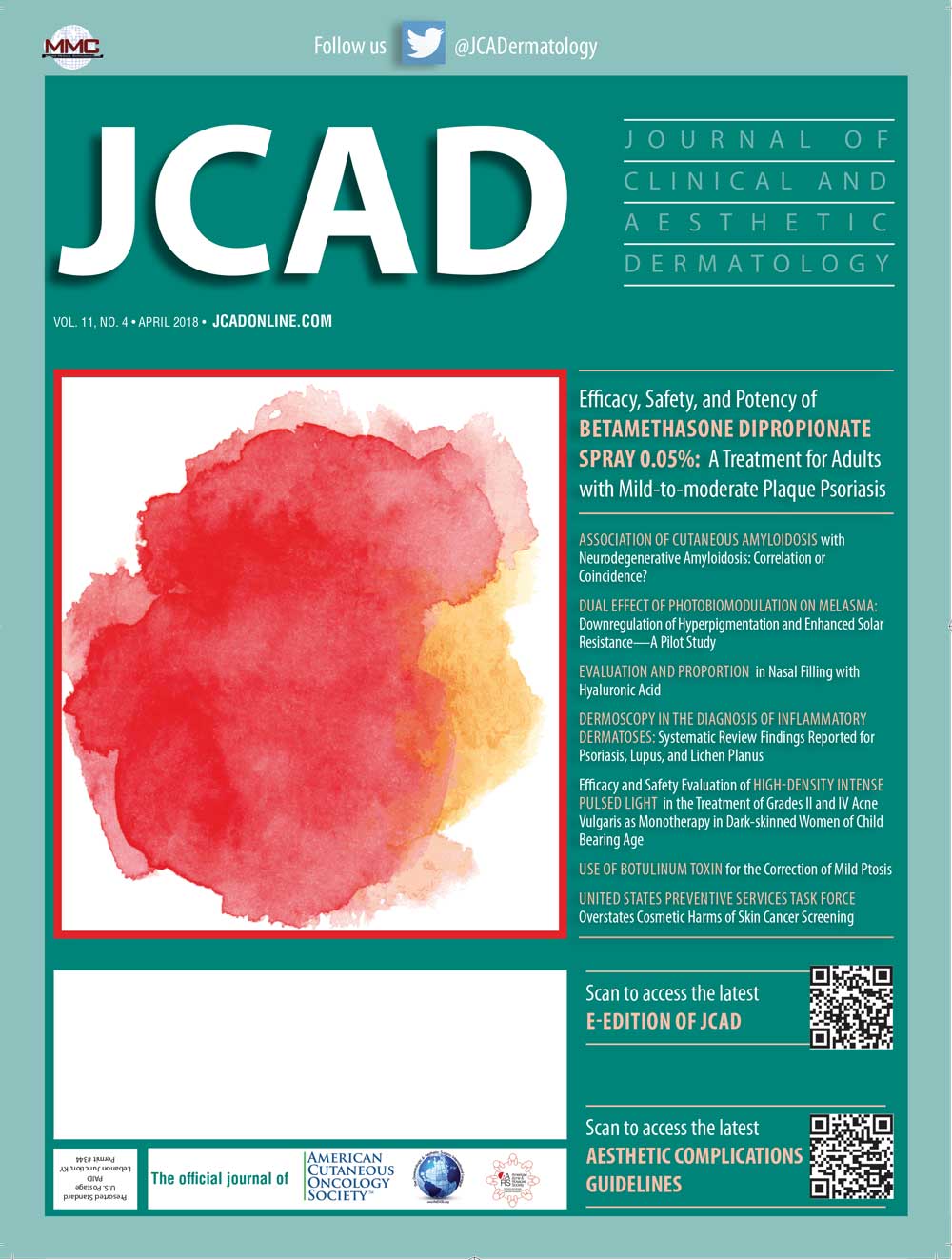 Dear Colleagues:
Dear Colleagues:
Welcome to the April 2018 issue of The Journal of Clinical and Aesthetic Dermatology (JCAD). We begin the issue with a study by Sidgiddi et al titled, “Efficacy, Safety, and Potency of Betamethasone Dipropionate Spray 0.05%: A Treatment for Adults with Mild-to-moderate Plaque Psoriasis.” In this randomized, vehicle-controlled, double-blind study, the authors assessed the efficacy and safety of a spray formulation of betamethasone dipropionate 0.05% (BD spray 0.05%; Sernivo™ Spray 0.05%; Promius Pharma, LLC; Princeton, New Jersey, USA), which has been developed for the topical treatment of psoriasis. Healthy adults with moderate psoriasis were included in the study. The authors also evaluated the potential for adrenal suppression and systemic absorption in a randomized, open-label study in healthy adults, as well as measured potency in two single-point, randomized, evaluator-blinded studies in healthy adults. Methods and results are described and discussed.
Next, in a case report by Awal and Kaur titled, “Association of Cutaneous Amyloidosis with Neurodegenerative Amyloidosis: Correlation or Coincidence?” the authors report a case of concurrent occurrence of skin and brain amyloidoses and explore the brain-skin axis connection.
Following this, in a pilot study titled “Dual Effect of Photobiomodulation on Melasma: Downregulation of Hyperpigmentation and Enhanced Solar Resistance—A Pilot Study” by Barolet, investigators evaluated the use of pulsed photobiomodulation to modulate melasma via the regulation of gene expression pertaining to skin pigmentation. Using a two-step approach via a split-face model, the researchers studied seven patients with bilateral dermal melasma who had formerly undergone unsuccessful treatments. Methods and results are described and discussed.
Next, in a review article by Bravo et al titled “Evaluation and Proportion in Nasal Filling with Hyaluronic Acid,” the authors present an objective review of the anatomy of the nasal region, the evaluation and indications of nasal filling with hyaluronic acid, a description of the technique, and brief discussion of associated complications.
Following this, in a review article by Cook et al titled “Dermoscopy in the Diagnosis of Inflammatory Dermatoses: Systematic Review Findings Reported for Psoriasis, Lupus, and Lichen Planus,” the authors describe and discuss the results of their literature review regarding use of dermoscopy in the evaluation of inflammatory skin conditions.
Next, in a study by Deshpande titled “Efficacy and Safety Evaluation of High-density Intense Pulsed Light in the Treatment of Grades II and IV Acne Vulgaris as Monotherapy in Dark-skinned Women of Child Bearing Age,” the researchers assessed efficacy and safety of intense pulsed light (IPL) therapy (Magma-F-SR; FormaTK Systems, Tirat Carmel, Israel) in the treatment of Grades 3 and 4 acne as monotherapy in dark-skinned women of child-bearing age. All patients were treated with IPL using a 530nm to 1,200nm filter once a week for a total duration of six weeks and were followed for an additional six weeks. Methods and results are described and discussed.
Following this, in a case series by Mustak et al titled, “Use of Botulinum Toxin for the Correction of Mild Ptosis,” the authors describe their technique for the correction of micro-ptosis and asymmetry using botulinum toxin administered to the pre-tarsal orbicularis.
And finally, in a commentary by Sobanko et al titled, “United States Preventive Services Task Force (USPSTF) Overstates Cosmetic Harms of Skin Cancer Screening,” the authors review the USPSTF 2016 recommendation for skin cancer screening in asymptomatic healthy adults, highlighting pertinent studies and currently accepted methods for pigmented lesion biopsy. The authors hope to encourage clinicians to more thoroughly analyze the USPSTF statement and consider its usefulness in the routine assessment and management of suspicious pigmented lesions in adult patients.
We hope you enjoy this issue of JCAD. As always, we welcome your feedback and submissions.
With regards,
James Q. Del Rosso, DO, FAOCD
Editor-in-Chief, Clinical Dermatology
Wm. Philip Werschler, MD, FAAD, FAACS
Editor-in-Chief, Aesthetic Dermatology
Seemal R. Desai, MD, FAAD
Associate Editor

